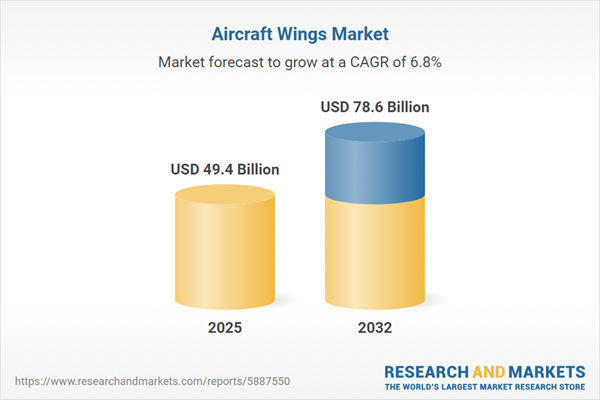Speak directly to the analyst to clarify any post sales queries you may have.
The aircraft wings market is evolving rapidly, shaped by technological innovation, stricter regulations, and rising expectations for efficiency and sustainability. Senior leaders face strategic opportunities and challenges as manufacturers, suppliers, and operators adapt to significant shifts in materials, production, and business models.
Market Snapshot: Aircraft Wings Market Size and Growth
The global aircraft wings market grew from USD 46.29 billion in 2024 to USD 49.40 billion in 2025, and is projected to achieve a CAGR of 6.84%, reaching USD 78.60 billion by 2032. Growth is underpinned by increased air travel, advancing design technologies, and regulatory initiatives supporting sustainability across aerospace applications.
Scope & Segmentation of the Aircraft Wings Market
This report delivers segmented analysis vital for investment planning, risk assessment, and opportunity identification within the aircraft wings sector. Major coverage includes:
- Application: Commercial Aircraft (including Business Jet, Narrow Body, Regional Jet, Turboprop, Wide Body), General Aviation (Multi Engine Piston, Single Engine Piston, Turboprop), Military Aircraft, Unmanned Aerial Vehicles
- Aircraft Type: Business Jet, Narrow Body, Regional Jet, Turboprop, Wide Body (Long Range, Medium Range, Ultra Long Range)
- Material: Aluminum (Aluminum Alloy, Aluminum Lithium), Composite (Aramid Fiber, Carbon Fiber Reinforced Polymer, Glass Fiber Reinforced Polymer), Titanium (Titanium Alloy)
- End User: Airlines, Defense, Leasing Companies, Private Owners
- Manufacturing Process: Casting, Composite Layup (Automated Layup, Hand Layup), Forging, Machining (CNC Machining, Manual Machining)
- Technology: Active Flow Control, Blended Wing Body, Morphing Wings, Winglets (Blended Winglets, Sharklet, Split Scimitar Winglets)
- Regions: Americas (North America: United States, Canada, Mexico; Latin America: Brazil, Argentina, Chile, Colombia, Peru), Europe, Middle East & Africa (Europe: United Kingdom, Germany, France, Russia, Italy, Spain, Netherlands, Sweden, Poland, Switzerland; Middle East: United Arab Emirates, Saudi Arabia, Qatar, Turkey, Israel; Africa: South Africa, Nigeria, Egypt, Kenya), Asia-Pacific (China, India, Japan, Australia, South Korea, Indonesia, Thailand, Malaysia, Singapore, Taiwan)
- Companies: The Boeing Company, Airbus SE, Spirit AeroSystems, Inc., Leonardo S.p.A., GKN Aerospace Services Limited, Mitsubishi Heavy Industries, Ltd., Kawasaki Heavy Industries, Ltd., FACC AG, Hindustan Aeronautics Limited, Saab AB
Key Takeaways for Senior Decision-Makers
- Next-generation wing design utilizes advanced composites and digital engineering platforms to achieve greater lift-to-drag ratios and lighter structures, enabling lower operational costs and improved sustainability.
- Growing regulatory requirements on noise emissions and carbon reduction are shaping the direction of technology investments and compelling greater OEM and supplier collaboration.
- Additive manufacturing, digital twins, and automated layup techniques are streamlining production, reducing waste, and allowing for tighter tolerances in complex aerodynamic profiles.
- Supply chain resilience is now a strategic priority, encouraging nearshoring, diversification of suppliers, and adoption of agile sourcing practices in response to tariff changes and global disruptions.
- Emerging wing technologies, such as morphing structures and active flow control, are increasingly central in capturing demand in both commercial and defense segments.
- Aftermarket services, including predictive maintenance and localized MRO facilities, are becoming key differentiators for providers aiming to extend asset life and support end users more effectively.
Impact of United States Tariffs Introduced in 2025
The introduction of new U.S. tariffs in 2025 on imported components has triggered a shift toward domestic sourcing and regional supply chain realignment. Manufacturers are investing in local capabilities to shorten lead times and reduce exposure to trade risk. Although innovative material use and recycling initiatives are helping to manage elevated input costs, flexibility in procurement and collaboration with policymakers remain critical to navigating ongoing tariff impacts.
Research Methodology & Data Sources
This report employs a dual-method research approach. Extensive secondary analysis covers technical literature, regulatory documents, and patent filings to establish market context. Primary research features interviews with engineers, procurement leaders, regulatory experts, and site visits to advanced wing production sites. Cross-referencing quantitative and qualitative data, validated by aerospace experts, ensures reliability of outcomes and actionable insights.
Why This Report Matters
- Provides an in-depth, segmental understanding crucial for C-level executives to align innovation, supply chain, and market-entry strategies with evolving trends in the aircraft wings sector.
- Supports strategic planning by highlighting the roles of sustainability initiatives, regional manufacturing ecosystems, and emerging defense and commercial technology needs.
- Enables leaders to benchmark key players’ approaches to advanced materials, digital transformation, and aftermarket services, informing competitive positioning.
Conclusion
The aircraft wings market is poised for transformation, driven by material innovation, digitalization, and regulatory evolution. Stakeholders that prioritize adaptability and invest in collaborative, sustainable solutions will strengthen their competitive position in the global aerospace industry.
Additional Product Information:
- Purchase of this report includes 1 year online access with quarterly updates.
- This report can be updated on request. Please contact our Customer Experience team using the Ask a Question widget on our website.
Table of Contents
3. Executive Summary
4. Market Overview
7. Cumulative Impact of Artificial Intelligence 2025
Companies Mentioned
The companies profiled in this Aircraft Wings market report include:- The Boeing Company
- Airbus SE
- Spirit AeroSystems, Inc.
- Leonardo S.p.A.
- GKN Aerospace Services Limited
- Mitsubishi Heavy Industries, Ltd.
- Kawasaki Heavy Industries, Ltd.
- FACC AG
- Hindustan Aeronautics Limited
- Saab AB
Table Information
| Report Attribute | Details |
|---|---|
| No. of Pages | 182 |
| Published | October 2025 |
| Forecast Period | 2025 - 2032 |
| Estimated Market Value ( USD | $ 49.4 Billion |
| Forecasted Market Value ( USD | $ 78.6 Billion |
| Compound Annual Growth Rate | 6.8% |
| Regions Covered | Global |
| No. of Companies Mentioned | 11 |









